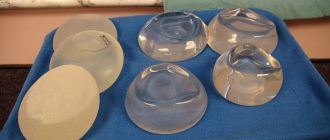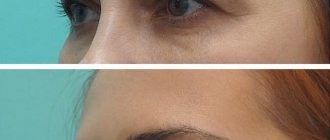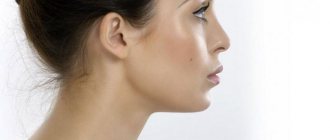Eyelid surgery is a plastic surgery that can significantly rejuvenate the area around the eyes, change the shape and shape of the eyes, remove bags under the eyes and sagging upper eyelids. Ptosis, or sagging tissue, can make you look sullen and tense, which is not conducive to positive communication. Do you want to restore youth and natural beauty to your face? In this case, sign up for a consultation at our clinic!
The advantages of our plastic surgery center are:
♦ Application of unique, progressive techniques ♦ Fame and positive reputation among patients ♦ Solid experience, Dr. Fadin’s experience in plastic surgery is more than 20 years ♦ Performing operations using methods that are safe for health ♦ Personal approach to each patient
Circular blepharoplasty
Over the years, human age is revealed by the eyes, which due to excess skin, tissue ptosis and wrinkles give the face a tired appearance. Cosmetic procedures help slow down the aging process, but if bad habits, chronic lack of sleep, and regular stress are present in the patient’s life, sooner or later this will affect the quality of the skin.
After 30 years, noticeable facial wrinkles and hernial bags under the eyes already appear, so it will no longer be possible to combat these imperfections only with cosmetic procedures, and it is worth thinking about more radical methods.
One of the options for solving the problem is circular blepharoplasty or blepharoplasty of the upper and lower eyelids, which is rightfully considered one of the most popular plastic surgeries for rejuvenation.
In recent decades, there has been a demand in society to preserve youth among both women and men. But not all patients are ready to immediately decide on a large-scale rejuvenating operation, for example, a facelift. Therefore, for these people, circular blepharoplasty is an opportunity to get a noticeable effect, with a short recovery period.
BLEPHAROPLASTY AT THE PIROGOV CLINIC IS AN OPERATION IN THE BEST PLASTIC SURGERY CLINIC IN ST. PETERSBURG.
*according to the ratings of the portals “Doctor Peter” and “Fontanka.ru” in 2021. Read more.
How is the procedure done?
If you want to have blepharoplasty, you need to make an appointment for a preliminary consultation with Vitaly Aleksandrovich Balandin at the plastic surgery clinic. At the first appointment, the doctor will conduct a visual examination, identify the patient’s wishes, and talk about the results of the procedure. Regardless of whether you need upper eyelid surgery or another type of operation, the second step is preparation: you need to undergo a series of laboratory tests to identify possible contraindications.
3 days before surgery, you must give up alcohol, and on the day of the procedure you should not consume food or water. Blepharoplasty takes from 30 minutes to an hour, anesthesia is selected by an experienced anesthesiologist depending on the individual situation, but in most cases intravenous sedation is used in combination with local anesthesia. Other plastic features:
- After the operation, you must temporarily stop using cosmetics - 5 days;
- The swelling subsides after 3-5 days;
- You can evaluate the effect after 5 days, but the final result will be noticeable after 1-3 months;
- Rehabilitation does not cause discomfort: a few days after the procedure, the client can use his usual cosmetics.
- You can plan to return to work in 5-7 days.
If you want to get rid of sagging eyelids or eliminate age-related changes in the eyelids, eyelid surgery will allow you to get rid of the defect once and for all. The result lasts 10-15 years. If necessary, blepharoplasty can be performed repeatedly.
What is circular blepharoplasty and what is its effect?
This operation is also called blepharoplasty of the upper and lower eyelids - a plastic intervention whose task is to lift the eyelid area. There are medical cases when the desired result can be achieved by eliminating excess skin and ptosis only in the upper or lower eyelids.
But when a more mature patient approaches a plastic surgeon or the tissue characteristics in the periorbital area suggest a more complex intervention, the specialist opts for circumferential blepharoplasty. Often, it is with this operation that many people begin their acquaintance with anti-aging plastic surgery.
However, there are cases when a young patient develops excess skin in the eyelid area and hernial sacs under the eyes. Then blepharoplasty of the upper and lower eyelids will prolong the youthful look and save a person from a tired look.
Are there any risks?
It is quite natural that any procedure performed through surgery involves certain risks. They cannot be excluded, because even if there is no medical error and the patient follows the recommendations, there is a factor of the body’s individual reaction. But such cases are exceptional.
Symptoms that occur in the first week after plastic surgery (hematomas, tearing, slight blurred vision, etc.) are considered normal, since these are signs of tissue trauma.
If you approach the choice of a surgeon without due attention or violate the doctor’s advice in the postoperative period, complications may arise: suture dehiscence, glaucoma, infection, tissue scarring and drooping eyelid.
In order to prevent the negative consequences of blepharoplasty, you should make sure of the qualifications and experience of the surgeon before the operation, follow all recommendations before and after blepharoplasty, and do not hide contraindications to blepharoplasty from the doctor.
Indications for surgery
The indication for blepharoplasty surgery of the upper and lower eyelids is the patient’s aesthetic dissatisfaction with the periorbital area due to:
- presence of bags under the eyes (hernial sacs)
- noticeable excess skin
- pronounced wrinkles
- sagging tissues
- eyelid asymmetry
- natural features of the structure of the eyes
In one circumferential blepharoplasty operation, a plastic surgeon is able to perform eyelid correction and give the patient a long-lasting result that will please him for many years.
Preparatory activities and blepharoplasty
At a preliminary appointment with the surgeon, the expected results of the operation are discussed. The specialist assesses the position of the eyebrows and, if they are drooping, may suggest a combined surgical option, which will include eyelid surgery and a facelift. In addition, it determines the degree of plasticity of the skin: if it is seriously reduced, in parallel with the plastic surgery, manipulations are carried out aimed at eliminating the risk of drooping of the lower eyelid.
Preoperative preparation includes comprehensive diagnostic studies:
- General blood analysis;
- Electrocardiography;
- Consultation with an anesthesiologist and highly specialized specialists (if necessary).
The surgery is performed in a hospital under general anesthesia and lasts from half an hour to two hours. The procedure is determined by the surgeon, guided by the patient’s testimony. The incisions are made along natural folds, which guarantees their invisibility in the future. The final stage is the application of a bandage, which is removed after four to six hours.
| Blepharoplasty technique | Distinctive features |
| Classical | The surgeon makes an incision along the fold of the upper eyelid in the subciliary area, after which he performs all the necessary manipulations: stretches the skin, excises hernias and excess skin. The procedure is effective for sagging upper eyelids and can be performed in conjunction with correction of its muscle tissue. |
| Transconjunctival | During surgery, an incision is made on the inside of the eyelid, so there is no need for sutures. During the process, the surgeon redistributes fatty tissue or removes excess fat without creating flaps of skin tissue. This technique is relevant for young patients whose eyelid defects are caused by genetic factors. |
| Comprehensive | The technique involves a combination of classical and transconjunctival techniques. Its use is advisable when correcting both eyelids. |
Preparing for surgery
In preparation for eyelid correction, the patient needs to find an experienced plastic surgeon whose portfolio includes sufficient results of work on circular blepharoplasty. The effect of the future operation directly depends on the qualifications of the specialist. It is also worth paying attention to the rating and reputation of the clinic where the operation is planned.
The technical equipment of the institution, the comfort of the hospital, compliance with all sanitary standards - this is an important aspect in choosing a clinic. Ultimately, it is the institution that is responsible before the law, so you should not skimp when it comes to plastic surgery. Correcting the shortcomings of a performed intervention is always more difficult than performing eyelid correction correctly the first time.
After a consultation with a plastic surgeon, it will be necessary to undergo a preoperative examination, during which the patient undergoes all the necessary laboratory tests, ECG, X-ray, consultation with a general practitioner and an anesthesiologist.
Surgical facelift methods at the Doctor Grishkyan clinic in Moscow
Photo from the operating room, face lift MAX lift with shortened scar.
There are several dozen facelift techniques. Some of them are widely known and used by many plastic surgeons. Some are aimed at rejuvenating all areas of the face, others are designed to rejuvenate a specific part. The leading role in modern modifications of surgical rejuvenation is given to the correction of the superficial muscular aponeurotic system SMAS (smas). This method can significantly improve the aesthetic result of the operation by eliminating age-related ptosis of the soft tissues of the cheeks and nasolabial folds, neck and chin areas.
- Advanced facelift SMAS - SUPERFICIAL MUSCULAR APONEUROTIC SYSTEM LIFT , currently the most famous facelift technique in the world. SMAS is a concept that stands for superficial muscular aponeurotic system of the face. She takes part in facial expressions. During the extended SMAS lift operation, incisions are made both in front of the auricle and behind it. Behind the ear they can be continued into the scalp. During the operation, sagging facial muscles are captured and tightened and then fixed in a new position. This method is quite traumatic and has a long rehabilitation period. However, it allows for the most complete facial rejuvenation and lifting at almost all levels of the muscular aponeurotic system of the face.
- MACS LIFT – MINIMAL ACCESS CRANIAL SUSPENSION LIFT . This type of facelift is understood as facial plastic surgery with a short skin incision and a vertical vector of tissue lifting. This is one of the most modern facelift techniques. And at the same time the least traumatic. This type of facial surgery is performed through minimal incisions that are made in front of the ear. MACS lift also allows you to rejuvenate the upper neck, chin area and correct jowls. During the operation, nasolabial folds can be smoothed out. The technique allows you to remove a large amount of excess skin, and tighten and firmly fix sagging facial tissues in the vertical direction. This operation can be performed on patients of all groups. MACS LIFT can be supplemented with lipofilling and eyelid surgery.
- In patients with severe neck laxity, platysmaplasty - PLATYSMA LIFT . A neck lift combined with a SMAS facelift is considered the best solution for rejuvenating a sagging, aging neck or jaw area. During a neck lift, plastic surgery of the pastisma, the superficial muscle of the neck, is performed. After tightening and removing excess fat, its edges are stitched together. It is possible to perform isolated platysmaplasty. In this case, incisions are made only in the fold around the earlobes and in the chin fold.
- Endoscopic face lift - SUBPERIOSTEAL FACELIFT. This is a progressive technique that allows you to perform facial rejuvenation with the least amount of scars and a fairly short rehabilitation period. The operation is performed using special instruments: a video camera, which is inserted through small incisions (up to 2 cm) in the scalp. Sometimes, if necessary, an additional incision is possible in front of the ear and in the mouth. Tissue tightening is carried out subperiosteally. Excess skin is not removed. That is why endoscopic facelift is indicated mainly for patients with stage 1 of aging.
Thus, we have looked at some popular methods of surgical facial rejuvenation. Some techniques can be combined with each other. Each tightening technique has its own characteristics. The correct choice of the required technique always depends on the surgeon. In our practice, we use almost all methods, both independently and by combining them. We determine the method together with the patient during diagnosis and consultation.
Progress of the operation
The patient is admitted to the clinic according to the surgical plan. He waits for his turn for the operation in the ward while all the necessary instruments for eyelid correction are prepared in the operating room. The duration of plastic surgery depends on the amount of work required, but usually takes about 2 hours. After removing excess skin and fat deposits, the plastic surgeon applies stitches, and the patient gains strength in the hospital room.
The patient is discharged from the clinic the next day after a morning examination by a plastic surgeon and treatment of sutures.
Rehabilitation period
The recovery period after circumferential blepharoplasty takes about a month. On the 10th day after surgery, the plastic surgeon removes the sutures. During this period, slight swelling and bruising still persist, but if you follow all the specialist’s recommendations and use healing ointments, they disappear over time. An important part in the rehabilitation period is played by restorative procedures in the cosmetology department, which help reduce swelling and hematomas, and also have a beneficial effect on tissue regeneration.
During the rehabilitation period, you need to give up active physical exercise, visiting the sauna, solarium and swimming pool. It is also best to avoid sun exposure if the surgery was performed in the spring or summer. This will avoid hyperpigmentation of the scar after eyelid correction.
When should circumferential blepharoplasty be done?
Patients of all ages resort to circumferential blepharoplasty. If by nature you do not like your eyelids, there is pronounced asymmetry, then you can perform it until you are 30 years old. Basically, when dissatisfaction is associated with signs of aging, patients turn to her after 30-35 years. At a more mature age, they begin to get acquainted with plastic surgery because of the psychological fear of more radical anti-aging operations, and after that, inspired by the result, they decide to undergo a facelift.






